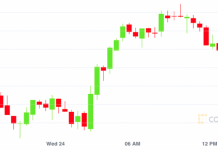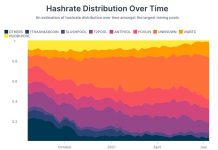As he acknowledged that consumer prices had risen faster than he or other central bank officials anticipated, the Federal Reserve Chairman had to explain his meaning of “transitory inflation”.
Bitcoin (BTC) rose above $40,000 on July 29, a day after the Federal Reserve hinted that it was getting nearer to unwinding its asset purchasing program that has boosted the economic recovery of the United States.
Before the Fed update, the benchmark cryptocurrency had reached $41,000. It lost some of its upside momentum shortly after the Federal Open Market Committee’s (FOMC) policy statement was released. This was followed by a press conference by Jerome Powell, the Fed chairman.
As economists expected, Fed officials left their monetary policy unchanged at the end of their two-day policy meeting. They stated that the U.S. had made greater progress towards its inflation and maximum employment goals, and that the Fed would continue to assess its stimulus policy over the next few months.
Bitcoin investors have been closely monitoring how soon the central bank might unwind its $120-billion-per-month bond-buying program. This is partially due to the bull run of the benchmark cryptocurrency, which ranged from $4,000 up to $65,000 in opposition the Fed’s loose monetary policy.
To inflate or not inflate?
Powell stated earlier that asset purchases by the Fed would continue until the Fed sees “substantial additional progress” in the U.S. economy’s recovery.
The Fed’s July 28 press conference was the first occasion it had to explain why it considers “substantial further advances.” Steve Liesman from CNBC asked Powell a question. He replied that it meant strong labor numbers and progress towards maximum employment.
Follow-up questions by reporters pressed Powell into explaining what “transitory” means, a term he and his office had repeatedly used in their previous FOMC statements to sideline concerns about rising inflation in the United States. Powell spent at least two minutes responding to the question. He noted that while inflation may rise in the near term, it won’t rise over the year.
“The increase in the consumer price will occur. They will not reverse, but we aren’t saying that. There will still be inflation but it will end. […] It doesn’t have to affect long-term inflation expectations. If it does, it won’t likely to impact inflation’s future. It is temporary and does not have a lasting impact on the inflation process.
Curvature Securities’ executive vice president for fixed income and repo, Scott Skyrm, pointed out that 10 times in the FOMC statement, the terms “inflation” and “price stability” were mentioned. This shows that rising consumer prices are a concern for Fed officials, even though they deny its existence by using the term “transitory”.
Lyn Alden Schwartzer is the founder of Lynalden Investment Strategy. She stated that Powell was trying to admit that inflation is not temporary in absolute terms. Essentially, the Fed chair acknowledged that it would result to “permanent significant price rises.” She added:
“Inflation, according to him, is transitory in terms of rate of change (year-over-year increases won’t stay at this rate).
Alden’s statements were inspired by one of her most recent newsletters. In it, she noted that the year-over-year inflation wobbled between highs and lows, thereby appearing transitory (the first chart below). The inflation rate continued to rise despite the fact that consumer prices were at an ever higher level after every inflationary spike. (see the second chart below).
Skyrm observed that Powell’s view of “substantial Further Progress” is limited to maximum employment. However, he completely ignores inflation fears. This means that the Fed’s tapering will respond to better labor data and not soaring consumer price.
Therefore, if the Delta variant of COVID-19 leads to another round of lockdowns, followed by more stimulus and unemployment benefits, one may not see normalization in the jobs market. This would lead to more inflation in the future.
“I suspect that many may agree that this was one of the most confusing Fed press conferences,” said Mohamed El-Arian, chief economic adviser at Allianz.
“Where there might be disagreement is why,” he said. This includes the balance between real economic uncertainties and what behavioral scientists refer to as ‘active inertia/too deeply wired convictions.”
Bitcoin price struggles to break $40,000 resistance
Bitcoin is now below $40,000 at the time of this publication.
The risk of cryptocurrency falling lower was due to the overbought relative weakness index (RSI), on a daily chart. An RSI reading higher than 70 usually limits future upside bids for assets.














